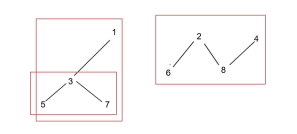
 Data Structure
Data Structure Networking
Networking RDBMS
RDBMS Operating System
Operating System Java
Java MS Excel
MS Excel iOS
iOS HTML
HTML CSS
CSS Android
Android Python
Python C Programming
C Programming C++
C++ C#
C# MongoDB
MongoDB MySQL
MySQL Javascript
Javascript PHP
PHP
- Selected Reading
- UPSC IAS Exams Notes
- Developer's Best Practices
- Questions and Answers
- Effective Resume Writing
- HR Interview Questions
- Computer Glossary
- Who is Who
Count number of trees in a forest in C++
Given vertices of a forest ( collection of trees). The goal is to find the number of trees in that forest. We will do this by running a DFS (depth first search) algorithm on the forest.
For Example
Input
edges = { { 1,3 }, {2,8}, {2,6}, {3,5}, {3,7}, {4,8} }
Output
Count of number of trees in a forest are: 3
Explanation
The number of trees that are present in the forest are −

Approach used in the below program is as follows −
In this approach we apply Depth First search algorithm on the graph recursively. We will increment count if every connected node is marked visited from one source ( which means a tree is formed ).
Take an integer vertice as a number of vertices on a graph.
Take a vector vector<int> vec[vertice] for storing vertices as integers.
Function insert(vector<int> vec[], int parent, int child) takes vec[] and adds an edge between nodes parent and child in that vector.
Add edge using vec[parent].push_back(child) and vec[child].push_back(parent).
Function recurred(int temp, vector<int> vec[], vector<bool> &check) applies DFS on graph from starting vertex temp.
Array check[temp] is used to set nodes as visited/unvisited using true/false.
Traverse vector vec[] using for loop and if check[vec[temp][i]] is false then call recurred(vec[temp][i], vec, check) recursively for connected nodes.
Function Trees_Forest(vector<int> vec[], int vertice) takes vec[] and returns the count of trees in the forest given as adjacency list in vec[].
Take initial count of forests as 0.
Take vector<bool> check(vertice, false) to mark vertices of graph as visited.
Traverse all vertices using for loop.
If check[i] is false then apply dfs using recurred(i, vec, check) and increment count.
At the end of all loops return count as result.
Example
#include<bits/stdc++.h>
using namespace std;
void insert(vector<int> vec[], int parent, int child){
vec[parent].push_back(child);
vec[child].push_back(parent);
}
void recurred(int temp, vector<int> vec[], vector<bool> &check){
check[temp] = true;
int size = vec[temp].size();
for(int i = 0; i < size; i++){
if (check[vec[temp][i]] == false){
recurred(vec[temp][i], vec, check);
}
}
}
int Trees_Forest(vector<int> vec[], int vertice){
int count = 0;
vector<bool> check(vertice, false);
for(int i = 0; i < vertice; i++){
if(check[i] == false){
recurred(i, vec, check);
count++;
}
}
return count;
}
int main(){
int vertice = 9;
vector<int> vec[vertice];
insert(vec, 1, 3);
insert(vec, 2, 8);
insert(vec, 2, 6);
insert(vec, 3, 5);
insert(vec, 3, 7);
insert(vec, 4, 8);
cout<<"Count of number of trees in a forest are: "<<Trees_Forest(vec, vertice);
return 0;
}
Output
If we run the above code it will generate the following output −
Count of number of trees in a forest are: 3

